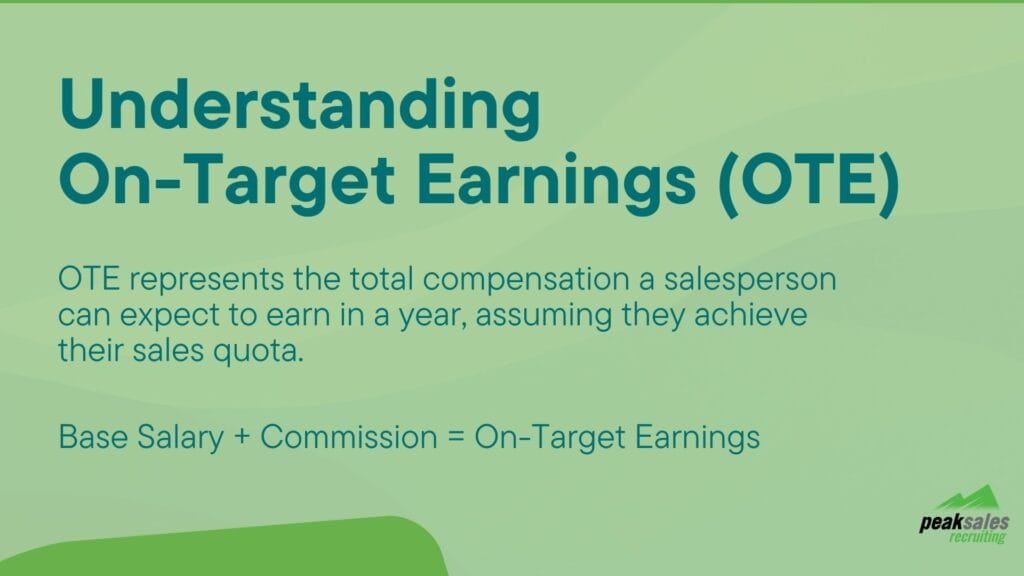Sales compensation is one of the biggest drivers of performance and often the most misunderstood. On-Target Earnings (OTE) plays a central role in setting expectations, aligning goals, and attracting top-tier talent. For employers, it’s a way to structure competitive offers. For candidates, it’s a signal of earning potential and role expectations. In this article, we break down what OTE really means, how it’s calculated, and how to use it to build a high-performing sales team, or a thriving career.
What is Sales OTE (On-Target Earning)?
Sales OTE represents the total compensation a salesperson can expect to earn in a year, assuming they achieve their sales quota. It’s a combination of two key elements:
- Salesperson’s Base Salary: A fixed amount paid regularly, offering financial security.
- Commission: Variable income earned by exceeding sales goals.
Think of OTE as a target — if you hit the bullseye (a rep’s annual quota), you take home the total amount.
OTE Formula
One of the simplest ways to understand OTE is through a basic formula: base salary plus commission. This calculation reflects the total earnings a salesperson can expect if they meet their sales targets. While the exact numbers vary by role and industry, this structure helps set clear expectations and align performance with compensation.

Why Transparent and Achievable OTE Matters
A well-designed OTE (on-target earnings) and compensation plan is a win-win for salespeople and employers. It motivates salespeople to achieve their goals and rewards them accordingly, leading to:
- Improved Sales Performance: When salespeople are incentivized through a clear commission structure, they’re driven to close more deals.
- Increased Job Satisfaction: Earning a good income and feeling valued by their employer leads to happier and more engaged salespeople.
For employers, a competitive compensation plan is essential for attracting and retaining top sales talent, which can help them meet overall revenue goals and other business objectives. Here are the key factors to consider when crafting an OTE:
- Transparency: An OTE compensation structure should be based on experience, role, and industry standards. This allows employers to be honest in job ads and job descriptions and allows sales professionals to negotiate a package that reflects their skills.
- Achievability: The OTE should be realistic and attainable. Factors like sales cycle length should be considered. For instance, enterprise and government sales with long cycles often have guaranteed OTEs in the first year to account for the extended sales process.
- Target Setting: Clear and achievable sales targets, or quotas, are essential for a functional OTE. Some roles, like BDRs (Business Development Representatives), might have a qualified meeting quota as part of their goals.
- Salary Structure: A healthy OTE typically includes a pay mix of base salary and commission. This provides salespeople with a solid base salary (fixed income) for financial stability while offering the potential to earn more through commissions. Customer success roles often lean more heavily on base salary with smaller bonuses.
Pro Tip: It’s important to ensure your OTE is aligned with your business goals and has clear targets to meet revenue targets for the sales organization. Some businesses use sales commission software to help with this.
Avoiding OTE Pitfalls:
- Unrealistic OTEs: An inflated OTE that’s nearly impossible to achieve will demotivate salespeople. The average rep on your team should be able to reach the OTE realistically.
- Complexity: The OTE calculation shouldn’t require advanced math skills to understand. Keep it simple and transparent for both employers and salespeople.
- Focus on Long-Term Success: A guaranteed OTE in the first year might be necessary for some roles, especially those with long sales cycles. This ensures new salespeople can establish themselves without solely relying on commissions.
By following these principles, employers can create a competitive OTE structure that attracts top talent, motivates performance, and leads to a successful sales team. Remember, good salespeople will go for the company that offers financial incentives.
How to Calculate OTE
Calculating OTE involves adding the base salary and expected commission earnings.
To calculate commission, use this formula: multiply the percentage commission rate by the expected sales revenue.
For example, if a salesperson has a 10% commission rate and is expected to sell $500,000 worth of products, their commission would be $50,000.
Add the base salary and commission for a total expected earnings amount to calculate OTE. For instance, if a salesperson has a $60,000 base salary and $50,000 in commission, their OTE would be $110,000.
Note: When drafting OTE plans, it’s best to loop in hiring managers during the hiring process to make sure compensation matches the industry standard. Job offers without a straightforward rep’s base salary can deter high-performing reps from applying for job postings.
Capped vs. Uncapped OTE
OTE structure can be either capped or uncapped.
“Capped OTE” refers to setting a maximum limit on commission earnings for salespeople, even if they exceed their quota.
- Pros: Benefits for the employer include predictable compensation costs and encouraging reps to focus on achieving their base quota rather than exceeding it significantly.
- Cons: Limited earning potential for high performers may impact their motivation after reaching the cap.
“Uncapped OTE” means no limit on how much commission sales representatives can earn, allowing for higher earnings.
- Pros: Can motivate top performers and attract ambitious salespeople.
- Cons: Quota attainment may be more difficult due to potentially aggressive targets, and income can be less predictable.
Job Titles and OTE Ranges
OTE varies depending on the sales role and industry. Here’s a glimpse into some typical ranges:
Sales
- Sales Development Representative (SDR): $50,000 – $70,000 OTE (often commission is mixed with a base salary)
- Account Executive (AE): $70,000 – $120,000 OTE (commission structure can vary)
- Enterprise Account Executive: $100,000+ OTE (uncapped commissions can push this significantly higher)
Customer Success
- Customer Success Manager: $60,000 – $100,000 OTE (typically tied to retention rates and often leans more on a base salary with a minor commission component)
The Bottom Line
It’s important to understand OTE and its components if you’re an employer or a candidate to confidently make informed decisions and navigate the world of sales compensation. Keep in mind that a high OTE is appealing, but having a quota that’s both realistic and attainable is equally essential.
OTE is just one piece of the puzzle. To motivate your team and drive consistent performance, your entire compensation plan needs to align with your sales goals. Check out our guide on building a sales force compensation plan that supports growth and retention.
For more sales tips and advice, visit our blog.



